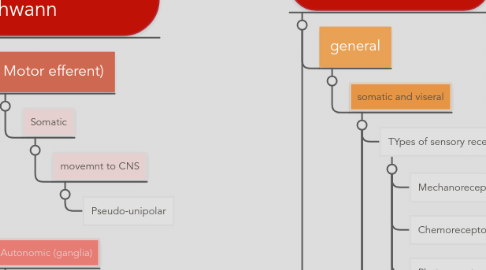
1. Neural cells
1.1. Ganglonic cells
1.1.1. microglial
1.1.1.1. immune
1.2. dendrocytes
1.2.1. Saltory conduction vs continual
1.3. Types of cells
1.3.1. Graymatter
1.3.1.1. dendrites cellbodies
1.3.1.2. processes
1.3.1.3. CNS
1.3.1.3.1. Surface-cortex
1.3.1.3.2. deep-nuclei
1.3.1.4. PNS
1.3.1.4.1. Ganglion
1.3.2. Whitematter
1.3.2.1. CNS
1.3.2.1.1. Nerve tracts
1.3.2.2. PNS
1.3.2.2.1. Nerves
1.4. CNS vs PNS
1.4.1. Oligodendrocytes Schwann cells
1.4.2. Nerve tracts, Nerves
1.4.3. Nuclei Ganglion
1.5. Ependymal
1.5.1. CSN fluid
2. CNS oligodendrocyte multiple capillaries
2.1. Spinal (sense) (2)
2.1.1. (3) Plexuses (around paraSy)
2.1.1.1. Cervical
2.1.1.1.1. C1-C4
2.1.1.1.2. Diaphram
2.1.1.2. Brachial (thoracic)
2.1.1.2.1. C5-T1
2.1.1.2.2. shoulder
2.1.1.3. Lumbosacral
2.1.1.3.1. L1-S4
2.1.1.3.2. lowerlimbs
2.1.1.4. Enteric
2.1.1.4.1. CNS to digestive
2.1.2. Tracts (2)
2.1.2.1. Ascending
2.1.2.1.1. Spinothalmus dorsal column
2.1.2.1.2. Sense Dorsal column, spinothalamus spinocerebellar Oblongada primary somatic sensory cortex
2.1.2.2. Descending
2.1.2.2.1. (lateral corticospinal tract)
2.1.2.2.2. pyramid (in medulla oblong) Lateral corticospinal tract
2.1.3. reflexes
2.1.3.1. receptor neuron interneuron motorneuron organ
2.2. Brain (5)
2.2.1. Cerebrum (2)
2.2.1.1. Cerebral Cortex
2.2.1.1.1. Frontal,parietal,occipital, temp
2.2.1.1.2. cognition
2.2.1.2. Basal Nuclei
2.2.1.2.1. -Substantia nigra Parkinsons
2.2.2. Diencephalon (DMT) (3)
2.2.2.1. thalamus and pineal
2.2.2.1.1. emotion
2.2.2.2. hypothalamus
2.2.2.2.1. homeostatis
2.2.3. Brainstem (4)
2.2.3.1. Midbrain (clear eyes)
2.2.3.1.1. eye, pupil
2.2.3.2. Pons (gum)
2.2.3.2.1. breathing, chewing
2.2.3.3. Medulla oblong running
2.2.3.3.1. has pyramids skeletal muscle
2.2.3.3.2. running. vomit, breath HR, balance, cough
2.2.3.4. Reticular formation (modafinil)
2.2.3.4.1. sleep wake cycle
2.2.4. Cerebellum (slackline)
2.2.5. Ventricles
2.2.5.1. Fourth ventricle
2.2.5.1.1. base of cerebellum
2.2.5.1.2. Choroid plexus by ventricles
2.3. Fluid
2.3.1. PAD (2)
2.3.1.1. outerlayers
2.3.1.1.1. epidural (pain)
2.3.1.1.2. Subarachnoid (spinal tap)
2.3.2. Ventricles
3. PNS (outsidebrain) Schwann
3.1. Motor efferent)
3.1.1. Somatic
3.1.1.1. movemnt to CNS
3.1.1.1.1. Pseudo-unipolar
3.2. Autonomic (ganglia)
3.2.1. Sympathetic (T1-T12 L1-L2) short-long
3.2.1.1. transmitter
3.2.1.1.1. Cholingeric Pre-gang Andergenic fiber NE (postgang)
3.2.1.2. function
3.2.1.2.1. blood pressure
3.2.1.3. Ganglia
3.2.1.3.1. Post-Nicotinergic
3.2.1.3.2. adenergic fibers post
3.2.2. Parasym C1-8 and S1-S5
3.2.2.1. Transmitter
3.2.2.1.1. Pre&post G-Ach
3.2.2.2. function
3.2.2.2.1. Digestion
3.2.2.3. Ganglia
3.2.2.3.1. post-has muscarinic
4. Sensory (PNS cont)
4.1. general
4.1.1. somatic and viseral
4.1.1.1. TYpes of sensory receptors
4.1.1.1.1. Mechanoreceptors
4.1.1.1.2. Chemoreceptors
4.1.1.1.3. Photoreceptor
4.1.1.1.4. Thermoreceptor
4.1.1.1.5. Nociceptor
4.1.1.2. touch
4.1.1.2.1. Merkel hair Meissner
4.1.1.3. Pressure
4.1.1.3.1. Paciniancorpusles Ruffini
4.1.1.4. Pain
4.1.1.4.1. Sharp rapid potential
4.1.1.4.2. Diffuse:burnin slower
4.1.1.4.3. Referred internal
4.2. special senses (3)
4.2.1. smell
4.2.1.1. ethmoid bone
4.2.1.2. Bipolar neuron
4.2.1.3. how it works
4.2.1.3.1. mucous. dendrite.OB
4.2.1.3.2. olfactory bulb/tract to CNS (I)
4.2.1.3.3. frontal. temporal
4.2.2. taste
4.2.2.1. Papillae
4.2.2.2. how it works
4.2.2.2.1. Tastebuds
4.2.2.2.2. Taste cells
4.2.2.2.3. taste hairs
4.2.2.2.4. Trigeminal (5)Facial (7) Glossopharynygeal (9) Vagus (10).
4.2.2.2.5. Parietal
5. Special senses contin eye and ear
5.1. vision
5.1.1. Parts
5.1.1.1. Lacrimal Apparatus
5.1.1.1.1. Lacrimal gland
5.1.1.1.2. Nasolacrimal duct
5.1.1.2. Eye muscles
5.1.1.2.1. rectus
5.1.1.2.2. Oblique
5.1.1.2.3. Lateral
5.1.1.2.4. Medially
5.1.1.2.5. superior and inferior
5.1.1.3. Accessory
5.1.1.3.1. Eyebrow
5.1.1.3.2. Pupil
5.1.1.3.3. Iris
5.1.1.3.4. Lower eye lid
5.1.2. chambers of eye (3)
5.1.2.1. anterior chamber
5.1.2.1.1. aqueous humor provide nutrients to inner eye
5.1.2.2. Poesterior chamber
5.1.2.2.1. behind AC, aqu hum
5.1.2.3. Vitreous chamber
5.1.2.3.1. vitrous humor, holds lens and retina
5.1.3. Tunics
5.1.3.1. Vascular tunic
5.1.3.1.1. Iris
5.1.3.1.2. Pupil
5.1.3.1.3. Ciliary body
5.1.3.1.4. Choroid
5.1.3.2. nervous tunic
5.1.3.2.1. Retina
5.1.3.3. Fibrous tunic
5.1.3.3.1. Schlera
5.1.3.3.2. Cornea
5.1.4. Pathway
5.1.4.1. Rhodopsin Retinal and opsin cones and rods
5.1.4.2. Optic nerve optic chiasm optic tract
5.1.5. defects
5.1.5.1. myopia hyeropia prebyopia astigmatism Glaucoma
5.1.6. Cranial nerves
5.2. hearing
5.2.1. Structure
5.2.1.1. External
5.2.1.1.1. Auricle
5.2.1.1.2. Tympanic
5.2.1.2. Middle
5.2.1.2.1. Malleus
5.2.1.2.2. Incus
5.2.1.2.3. Stapes
5.2.1.2.4. Oval window
5.2.1.3. Inner
5.2.1.3.1. Cochlea
6. Muscles
6.1. Types
6.1.1. Skeletal
6.1.1.1. Characteristics
6.1.1.1.1. multinuclei
6.1.1.1.2. Cylindrical
6.1.1.1.3. longest
6.1.1.1.4. striated
6.1.1.2. Coverings
6.1.1.2.1. epimysium (entire)
6.1.1.2.2. Perimysium (fasciulis)
6.1.1.2.3. endomysium (fibers)
6.1.1.3. Cellular structure
6.1.1.3.1. muscle fiber- cell fasciculi- many cells
6.1.1.3.2. Sarcolemma
6.1.1.3.3. T-tubules
6.1.1.3.4. SR
6.1.1.4. cellular mechanism of action
6.1.1.5. anaerobic
6.1.1.5.1. creatine phosphate in mitochondria
6.1.1.5.2. 18X less ATP but faster
6.1.1.6. Fatigue
6.1.1.6.1. muscular fatigue
6.1.1.7. contraction types
6.1.1.7.1. isometric
6.1.1.7.2. isotonic
6.1.2. Cardiac
6.1.2.1. Characteristics
6.1.2.1.1. 1 nucleus
6.1.2.1.2. branching
6.1.2.1.3. intercalated disks
6.1.3. Smooth
6.1.3.1. no striation
6.2. Phases
6.2.1. Lag
6.2.2. Contraction
6.2.3. Relaxation
6.3. Anatomy
6.3.1. Neck
6.3.1.1. Flex
6.3.1.1.1. Sternocleidomastoid
6.3.1.1.2. Scalene
6.3.1.2. Extend
6.3.1.2.1. trapezius
6.3.2. Lungs
6.3.2.1. inhalation
6.3.2.1.1. External intercostals
6.3.2.1.2. External obliques
6.3.2.1.3. Scalenes
6.3.2.2. Exhalation
6.3.2.2.1. Internal intercostals
6.3.2.2.2. Rectus abdominis
6.3.3. Injection sites
6.3.3.1. Gluteus medius
6.3.4. Arms
6.3.4.1. elbow
6.3.4.1.1. flex
6.3.4.1.2. Extend
6.3.4.2. shoulders
6.3.4.2.1. Deltoid
6.3.4.3. elbow
6.3.5. Legs
6.3.5.1. extend knee
6.3.5.1.1. quadricpes femoris
6.3.5.2. Flex knee
6.3.5.2.1. Sartorius
6.3.5.3. Extend hip
6.3.5.3.1. Hamstring
6.3.6. Feet
6.3.6.1. Plantar flex insertion at Calcaneal tendon
6.3.6.1.1. Gastrocnemius
6.3.6.1.2. Soleus
